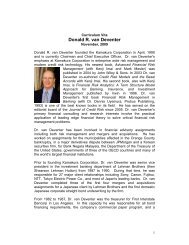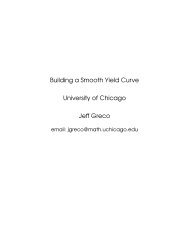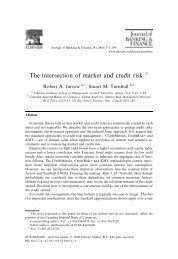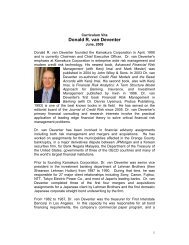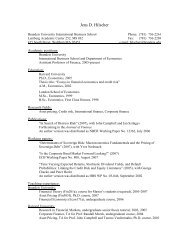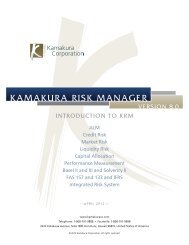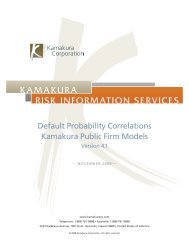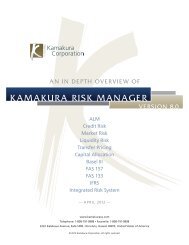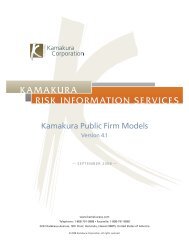KAMAKURA RISK MANAGER - The Kamakura Corporation
KAMAKURA RISK MANAGER - The Kamakura Corporation
KAMAKURA RISK MANAGER - The Kamakura Corporation
You also want an ePaper? Increase the reach of your titles
YUMPU automatically turns print PDFs into web optimized ePapers that Google loves.
<strong>KAMAKURA</strong> <strong>RISK</strong> <strong>MANAGER</strong><br />
INTRODUCTION TO KRM<br />
ALM<br />
Credit Risk<br />
Market Risk<br />
Basel II<br />
FAS 157<br />
FAS 133 Integrated Risk System<br />
VERSION 7.0<br />
—SEPTEMBER 2008 —<br />
www.kamakuraco.com<br />
Telephone: 1-808-791-9888 • Facsimile: 1-808-791-9898<br />
2222 Kalakaua Avenue, 14th Floor, Honolulu, Hawaii 96815, United States of America<br />
© 2008 <strong>Kamakura</strong> <strong>Corporation</strong>. All rights reserved.
Contents<br />
I. Introduction to <strong>Kamakura</strong> Risk Manager<br />
II. KRM Features and Benefits<br />
III. <strong>Kamakura</strong> Risk Technology and Innovation<br />
IV. Rationale for KRM’s Integrated Approach to Risk Management<br />
V. KRM – Macro Factors in Enterprise Risk Management<br />
VI. KRM – Transaction and Loan Level Detail<br />
VII. KRM – More than VAR and Credit-Adjusted VAR<br />
VIII. KRM – Interest Rate Risk and Asset and Liability Management<br />
IX. KRM – Transfer Pricing and Performance Measurement<br />
X. KRM – Market Risk<br />
XI. KRM – Credit Risk and Credit Portfolio Management<br />
XII. KRM – Basel II Capital Calculations<br />
XIII. KRM – Capital Allocation<br />
XIV. KRM and Non-Maturity Deposits<br />
XV. KRM – Liquidity Risk Management<br />
XVI. KRM and Insurance<br />
XVII. KRM for FAS 157 “Level 3” Valuations, FAS 133/IAS 39 Hedge Accounting Calculations<br />
XVIII. KRM-lm for Limits Management, KRM-lp for Loan Pricing<br />
XIX. KRM-dm for Data Mapping, KRM-rp for Web-based Reporting<br />
XX. KRM Securities Coverage<br />
XXI. KRM Modeling Choices<br />
XXII. KRM Processing Volumes and Speed<br />
XXIII. KRM Default Probabilities<br />
XXIV. KRM Links to <strong>Kamakura</strong> Risk Information Services (KRIS) Default Probabilities<br />
XXV. About <strong>Kamakura</strong> <strong>Corporation</strong><br />
2<br />
© 2008 <strong>Kamakura</strong> <strong>Corporation</strong>. All rights reserved.
I.<br />
Introduction<br />
In the credit crisis of 2007-2008, the chief executive officers of Citigroup, Merrill Lynch,<br />
Bear Stearns, Wachovia and UBS were fired because of risk management failures at their<br />
organizations. Countrywide Financial was sold to Bank of America in a distress sale for the<br />
same reason. Without exception, these institutions relied on legacy interest rate risk, market<br />
risk, and credit risk systems that were simply unable to answer one basic question: What<br />
happens to our institution if home prices drop by 20%? <strong>Kamakura</strong> Risk Manager (KRM) is<br />
designed to answer this and many closely related questions in order to give management,<br />
the Board of Directors, shareholders and regulators an accurate view of the total risk of the<br />
organization, including traditional narrowly defined risk “silos”. KRM is a total risk system<br />
that is used for asset and liability management, interest rate risk, transfer pricing, liquidity<br />
risk, credit risk, Basel II capital ratios, capital allocation, risk-adjusted return on capital, and<br />
market-oriented accounting calculations like FAS 133/IAS 39 and FAS 157.<br />
3<br />
© 2008 <strong>Kamakura</strong> <strong>Corporation</strong>. All rights reserved.
II.<br />
III.<br />
<strong>Kamakura</strong> Risk Manager Features & Benefits<br />
<strong>Kamakura</strong> Risk Manager, first offered commercially in 1993, has experienced continuous<br />
expansion and improvement since the first lines of code were written in 1990. <strong>The</strong> KRM<br />
system is written in modern C++ class libraries that are constantly being improved from<br />
a speed and accuracy point of view. KRM version 7.0, for example, contains much more<br />
functionality but 19% fewer lines of code than KRM version 6.3. KRM comes with a rich<br />
data base architecture that is Open Data Base Connectivity compliant with proper security.<br />
KRM runs on both Windows and Unix, and relational data bases like MS SQL Server, Oracle,<br />
and Sybase can all be used with KRM. <strong>Kamakura</strong> Risk Manager is designed as a multiplemodels<br />
risk management system, featuring a rich array of interest rate simulation techniques,<br />
default modeling approaches, prepayment simulation alternatives, and embedded options<br />
valuation methodologies. <strong>Kamakura</strong> Risk Manager is delivered with an optional set of<br />
Java-based web tools including the KRM-Risk Portal (rp) for wide dissemination of risk<br />
reports around the organization, KRM-Data Manager (dm) for easy data loading to KRM<br />
tables, KRM-Limits Manager (lm) for state of the art risk limits monitoring, and KRM-Loan<br />
Pricing (lp) for modern risk-adjusted return on capital loan pricing. KRM produces cash<br />
flows, financial accruals, and valuations at all user-defined forward time periods for the full<br />
range of financial instruments, from collateralized debt obligation tranches to mortgage<br />
backed securities to simpler instruments like bonds, deposits, loans, credit default swaps,<br />
options, interest rate swaps, life insurance policies, non-maturity deposits, foreign exchange<br />
transactions, and so on.<br />
<strong>Kamakura</strong> <strong>Corporation</strong> Risk Technology and Innovation<br />
<strong>Kamakura</strong> is the leader in modern integrated risk management because of the 1995 insights<br />
of <strong>Kamakura</strong>’s Managing Director for Research, Professor Robert Jarrow. Professor Jarrow,<br />
who also serves as senior research fellow at the Federal Deposit Insurance <strong>Corporation</strong> and<br />
Professor at Cornell University, linked credit risk with a random interest rates framework<br />
in his seminal paper with Stuart Turnbull. From that point in time, <strong>Kamakura</strong> has been<br />
dedicated to a completely integrated approach to risk management software design.<br />
Professor Jarrow is assisted in research efforts by <strong>Kamakura</strong> founder Dr. Donald R. van<br />
Deventer, named to the <strong>RISK</strong> Hall of Fame with Prof. Jarrow in 2002, and Professor Jens<br />
Hilscher, named senior research fellow in 2008. More than ten <strong>Kamakura</strong> staff members have<br />
contributed to 7 risk management books and over 140 published research papers.<br />
4<br />
© 2008 <strong>Kamakura</strong> <strong>Corporation</strong>. All rights reserved.
IV.<br />
Rationale for KRM’s Integrated Approach to Risk<br />
Management<br />
Now widely understood is the fact that traditional approaches to “silo” risk management are<br />
simply special cases of best practice integrated risk management: a multi-period simulation<br />
of random changes in the macro-economic environment where the default probabilities of all<br />
counterparties, from retail to corporate to sovereign, move up and down with the economy.<br />
All cash flows, financial accruals, defaults and recoveries are captured through this multiperiod<br />
simulation, and embedded options are exercised with the user-specified degree of<br />
rationality. As the graph shows, the risk silos for the most part differ in only two dimensions:<br />
whether the simulation is multi-period (the general case) or single period (a special case), and<br />
whether or not defaults are “turned on” (the general case) or “turned off ” (the special case).<br />
All risk analysis is a special case of multi-period credit risk analysis<br />
Special Case:<br />
No Defaults<br />
General Case:<br />
Allow Defaults<br />
Risk-factor Driven Defaults<br />
Special Case:<br />
Single Period<br />
Analysis with No New<br />
Assets or Liabilities<br />
Traditional VAR for<br />
Market Risk<br />
Credit-Adjusted VAR<br />
General Case:<br />
Multi-Period<br />
Analysis with Cash Flow<br />
Reinvestment and New<br />
Assets and Liabilities<br />
Traditional ALM for<br />
Interest Rate Risk<br />
Best Practice Multiperiod<br />
Credit-Adjusted<br />
Simulation and Valuation<br />
for Integrated Risk<br />
Management, Capital<br />
Allocation, and Total<br />
Balance Sheet Risk<br />
Hedging<br />
5<br />
© 2008 <strong>Kamakura</strong> <strong>Corporation</strong>. All rights reserved.
V.<br />
KRM – Macro Factors in Enterprise Risk Management<br />
After peaking in late 2006, home prices in the United States began to drop at a rate that is<br />
unprecedented in modern U.S. financial history. <strong>The</strong> graph below shows the Case-Shiller<br />
home price indices for the major metropolitan areas in the United States. On June 24,<br />
2008, the futures contracts on the same indices were showing home price declines from<br />
the September 2006 peak in Los Angeles, for example, of 39% through the November 2012<br />
futures contract. <strong>The</strong> fact that home prices were a critical risk factor for major financial<br />
institutions was not a surprise. On December 10, 2003, <strong>Kamakura</strong> Managing Director for<br />
Research Professor Robert Jarrow and four co-authors published the Loss Distribution<br />
Model mandated by the U.S. Congress for the Federal Deposit Insurance <strong>Corporation</strong>. <strong>The</strong><br />
study explicitly identified home prices as one of three macro-factors driving correlated<br />
default of U.S. banks.<br />
Some of the financial institutions with the largest losses from the 2007-2008 credit crisis have<br />
explicitly admitted that the losses stemmed from a lack of understanding of the exposure<br />
that the companies had to home prices. For example, Ann Reese, chairwoman of Merrill<br />
Lynch’s audit committee, said the board had had “numerous discussions’’ with management<br />
about its investments in the months before the credit crisis. “<strong>The</strong> board initially didn’t realize<br />
that prices of CDOs were linked to the U.S. housing market,” she said. “<strong>The</strong> CDO position<br />
did not come to the board’s attention until late in the process,’’ said Reese, a former chief<br />
6<br />
© 2008 <strong>Kamakura</strong> <strong>Corporation</strong>. All rights reserved.
financial officer of ITT Corp. who now is co-executive director of the non-profit Center for<br />
Adoption Policy. “For reasons that we have subsequently explored, there was not a sense<br />
that these triple-A securities should be included in the overall exposure to residential real<br />
estate.’’ 1 Another example comes from the Shareholders’ Report on UBS’s Write-Downs<br />
(April 18, 2008) on the reasons for UBS’s massive losses in real-estate-related CDO tranches:<br />
“Whilst there were a number of credit spread RFL [risk factor limits] limits in place, there<br />
was no RFL [risk factor limit] that specifically addressed certain factors relevant to Subprime<br />
exposure, such as delinquency rates or residential real estate price developments.”<br />
<strong>Kamakura</strong> Risk Manager gives risk managers, senior management, the Board of Directors,<br />
shareholders, and regulators the capability to explicitly analyze the total risk impact of<br />
macro-economic factors like home prices, interest rates, foreign exchange rates, stock prices,<br />
oil prices, commercial real estate, and commodity prices.<br />
VI.<br />
VII.<br />
KRM – Transaction and Loan Level Detail<br />
<strong>Kamakura</strong> Risk Manager is designed to operate at any level of granularity in portfolio data,<br />
but the “best practice” users of KRM use the most detailed portfolio data possible: loan and<br />
transaction level data. In the New York Times on April 27, 2008, a senior Moody’s official<br />
was quoted as saying the rating agencies did not look at individual loan files in its ratings of<br />
CDOs. <strong>Kamakura</strong>’s view is that a clear understanding of total risk can only be obtained by<br />
assembling the total risk of the institution, transaction by transaction. That is what KRM is<br />
designed to do.<br />
KRM – more than VAR and Credit-Adjusted VAR<br />
On January 28, 2008 Bloomberg.com reported that Merrill Lynch’s value at risk was<br />
calculated at $92 million compared to actual losses from the credit crisis of $18 billion, 200<br />
times larger than measured risk levels. <strong>Kamakura</strong> Risk Manager includes the traditional<br />
value at risk calculations, both historical VAR and variance-covariance based value at<br />
risk. KRM also includes important extensions to the concept to avoid the kind of risk<br />
measurement errors that Merrill Lynch experienced. KRM includes a full multi-period value<br />
at risk calculation that allows for dynamic changes in portfolio or balance sheet composition<br />
and VAR on a fully default adjusted basis. Cash flows are re-invested, options are exercised,<br />
and so on. Standard VAR and credit VAR make an unrealistic assumption that there is only<br />
one time period in the analysis and that the beginning balance sheet stays unchanged. Users<br />
have this option in KRM but the best practice multi-period VAR calculation is much more<br />
realistic because the balance sheet evolves over time as some transactions mature and new<br />
transactions are added in a predictable fashion.<br />
1<br />
Bloomberg.com, April 24, 2008.<br />
7<br />
© 2008 <strong>Kamakura</strong> <strong>Corporation</strong>. All rights reserved.
VIII.<br />
IX.<br />
X.<br />
XI.<br />
KRM – Interest Rate Risk and Asset and<br />
Liability Management<br />
<strong>Kamakura</strong>’s senior management team has more than 100 years experience as ALM and<br />
interest rate risk managers. <strong>Kamakura</strong> Risk Manager’s powerful ALM capabilities include<br />
user-defined multi-factor interest rate models, multiple approaches to prepayment analysis<br />
including state of the art logistic probabilities of prepayment, dynamic movements in new<br />
business, state of the art options models consistent with the work of Professor Robert Jarrow,<br />
and modern valuation techniques for valuing complex assets and liabilities like life insurance<br />
policies, bank owned life insurance, non-maturity deposits, servicing rights, and so on. KRM<br />
allows up to 999 user-defined time periods of any length.<br />
KRM – Transfer Pricing and Performance Measurement<br />
As <strong>Kamakura</strong>’s van Deventer, Imai and Mesler noted in their 2004 book Advanced<br />
Financial Risk Management, performance measurement and transfer pricing have changed<br />
enormously since Wm. Mack Terry and his team at Bank of America invented the transfer<br />
pricing concept at Bank of America in 1973. <strong>Kamakura</strong> Risk Manager uses the exact date<br />
of cash flow, adjusted for holidays, weekends, business day conventions and so on, to assign<br />
a cost of funds to each asset and a credit for funds for each liability. Users define which<br />
yield curve is the basis for transfer pricing, so appropriate adjustments can be made for the<br />
underlying liquidity and credit risks of the instrument being transfer priced. <strong>Kamakura</strong> Risk<br />
Manager comes with a wide array of yield curve and credit spread smoothing techniques and<br />
methodologies for transfer pricing assets and liabilities with embedded options.<br />
KRM – Market Risk<br />
As noted above, <strong>Kamakura</strong> Risk Manager includes both traditional approaches to value at<br />
risk and credit adjusted value at risk and a much more modern approach: a dynamic multiperiod<br />
credit-adjusted value at risk. This flexibility allows market risk managers to replicate<br />
legacy systems while moving forward to a more modern approach that allows multiple VAR<br />
horizons and an analysis period as far beyond the traditional 10-day VAR calculation as the<br />
user thinks is appropriate. Many KRM users, for example, look at VAR analysis where the<br />
time horizon is many years.<br />
KRM – Credit Risk and Credit Portfolio Management<br />
<strong>Kamakura</strong> Risk Manager provides credit risk managers with a steady way forward from<br />
traditional reliance on internal and external ratings to a full multi-period macro-factor driven<br />
simulation where default probabilities for all counterparties (from retail to small business to<br />
listed companies to sovereigns) rise and fall with the economy. It is the latter approach that<br />
provides true “see through” risk assessments of exposure to macro factors like home prices,<br />
8<br />
© 2008 <strong>Kamakura</strong> <strong>Corporation</strong>. All rights reserved.
avoiding the losses that Merrill Lynch and UBS incurred because of the lack of transparency<br />
in macro-factor risk. <strong>Kamakura</strong> Risk Manager users can derive “delta hedges” on total<br />
portfolios and full balance sheets for each macro factor. <strong>Kamakura</strong> Risk Manager allows the<br />
use of internal ratings, internal default models, third party ratings and default models, and<br />
the <strong>Kamakura</strong> Risk Information Services public firm and sovereign default models.<br />
XII.<br />
XIII.<br />
KRM – Basel II Capital Calculations<br />
Many financial institutions have learned that Basel II requires more than a “risk weight<br />
multiplier.” <strong>The</strong> Capital Accords from the Basel Committee on Banking Supervision<br />
incorporate a complex set of rules as to what risk weight should be assigned to a particular<br />
asset. <strong>Kamakura</strong> Risk Manager includes the full set of rules to make these calculations in a<br />
very efficient and accurate manner. <strong>Kamakura</strong> and its distributors have installed KRM for<br />
Basel II purposes from Warsaw to Hong Kong, with the appropriate modifications through<br />
the KRM-rp web based reports portal for unique national Basel II implementations. In<br />
addition to Basel II calculations within <strong>Kamakura</strong> Risk Manager, <strong>Kamakura</strong>’s risk experts<br />
provide advisory services to clients around the world on credit modeling, Basel II-compliant<br />
model audits and other key Basel II-related topics.<br />
KRM – Capital Allocation<br />
<strong>Kamakura</strong> Risk Manager’s dynamic balance sheet simulation capabilities clearly<br />
demonstrate that capital requirements have a term structure. Bank capital needs grow as the<br />
time horizon lengthens and when the business cycle turns down. <strong>Kamakura</strong>’s multi-period<br />
simulation show the period by period picture of that capital needed to achieve a target<br />
institutional rating, default probability and likelihood of survival. Stress testing of economic<br />
capital in KRM signals that macro-economic factors such as interest rates, home prices, oil<br />
prices, stock market prices, foreign exchange rates and commercial real estate prices impact<br />
capital requirements.<br />
9<br />
© 2008 <strong>Kamakura</strong> <strong>Corporation</strong>. All rights reserved.
XIV.<br />
KRM and Non-Maturity Deposits<br />
On September 14, 2007 the Bank of England was forced to intervene to protect Northern<br />
Rock against the first bank run in the United Kingdom in more than a century. <strong>The</strong> chart at<br />
the left shows that Northern Rock, based in Newcastle, lost 63% of its customer accounts and<br />
deposits from banks as the bank’s default probability rose approaching December 31, 2007.<br />
Many bankers overlook the fact that demand and savings deposit volumes are highly sensitive<br />
to the credit risk of the bank itself. KRM allows users to model “non-maturity” deposit<br />
volumes and their link to macro-economic factors and bank risk with maximum accuracy.<br />
<strong>Kamakura</strong> executives Professor Robert Jarrow and Dr. Donald R. van Deventer have<br />
published extensively on how modern derivatives technology can be used to measure the<br />
profitability and risk profile of ordinary deposits.<br />
10<br />
© 2008 <strong>Kamakura</strong> <strong>Corporation</strong>. All rights reserved.
XV.<br />
KRM – Liquidity Risk Management<br />
In January 2008 Bank of America announced it would buy mortgage lender Countrywide<br />
Financial <strong>Corporation</strong>. Like the case of Northern Rock, home price declines were devastating<br />
for Countrywide’s mortgage business. As investors perceived higher default risk for<br />
Countrywide, 5 year credit default swaps on Countrywide broke out of a narrow range between<br />
50 and 100 basis points and climbed to almost 300 basis points by September 30, 2007. <strong>The</strong><br />
result was a 94% decline in Countrywide’s ability to issue commercial paper. By December 31,<br />
2007, credit default swap quotes exceeded 800 basis points and Countrywide was completely<br />
shut out of the commercial paper market. KRM allows users to carefully measure how<br />
movements in macro-economic factors like home prices and interest rates can affect liquidity<br />
risk and the institution’s ability to fund itself with both retail and wholesale deposits.<br />
11<br />
© 2008 <strong>Kamakura</strong> <strong>Corporation</strong>. All rights reserved.
XVI.<br />
KRM and Insurance<br />
<strong>Kamakura</strong> Risk Manager allows users to simulate a rich array of insurance events. Using<br />
modern probability techniques, users can simulate the probability of occurrence of events<br />
like default/no default, prepay/don’t prepay, pay on a life insurance policy or don’t pay, and so<br />
on. Using KRM, leading edge actuaries can explicitly incorporate the impact of the economy<br />
on mortality rates, as recent economic developments in Russia and Japan make so clear.<br />
Similarly, the advance of medical technology and the impact on mortality of new diseases<br />
can be simulated in a rich and realistic way, consistent with the most recent developments in<br />
medical statistics.<br />
KRM for FAS 157 “Level 3” Valuations, FAS 133/IAS 39<br />
XVII.<br />
Hedge Accounting Calculations<br />
Financial Accounting Standard 157 requires institutions to accurately model thinly traded<br />
“hard to value” assets. KRM provides a state of the art framework that generates completely<br />
transparent valuations and an understanding of how bid-offered spreads in thinly traded<br />
markets reflect sampling error and other uncertainties in the valuation process. <strong>Kamakura</strong><br />
consultants are actively engaged in valuation services using KRM for sophisticated financial<br />
institutions around the world.<br />
Both U.S. and international accounting standards require that institutions seeking hedge<br />
accounting treatment justify a hedge by showing that market values of the assets being<br />
hedged are appropriately correlated with the hedging instrument. KRM automates the<br />
process of showing both prospective and historical hedge-related correlations.<br />
XVIII.<br />
KRM-lm for Limits Management, KRM-lp for Loan Pricing<br />
KRM Limits Manager is a web-based add-on to KRM that allows users to specify complex<br />
rules and limits for credit and trading risk exposure.<br />
<strong>The</strong> KRM Loan Pricing module is another web-based add-on to <strong>Kamakura</strong> Risk Manager<br />
which allows KRM’s sophisticated capital allocation simulations to be used to price<br />
individual loans according to the financial institution’s pricing policies. It is currently utilized<br />
by hundreds of lending officers world-wide.<br />
XIX.<br />
KRM-dm for Data Mapping, KRM-rp for Web-based<br />
Reporting<br />
<strong>The</strong> KRM Data Mapping module is a web-based tool used to automate the mapping of<br />
market data and client portfolio data to standard KRM table formats. <strong>The</strong> efficiency of the<br />
KRM-dm tool is one of the many reasons why <strong>Kamakura</strong> has a flawless installation record<br />
12<br />
© 2008 <strong>Kamakura</strong> <strong>Corporation</strong>. All rights reserved.
for KRM and an excellent reputation for fast and efficient installations.<br />
<strong>The</strong> KRM Risk Portal KRM-rp provides an array of standard web-based reports designed for<br />
the “read only” KRM user, those analysts who need to view and analyze the risk management<br />
information produced by KRM without the need to run the KRM system themselves. KRM-rp<br />
is used by sophisticated clients around the world. KRM-rp has recently been expanded to allow<br />
users to view proprietary data in client-defined tables in addition to reading and displaying data<br />
in the standard KRM data architecture. KRM-rp is also the vehicle for the display of risk reporting<br />
defined by national financial institutions regulators around the world.<br />
XX.<br />
XXI.<br />
XXII.<br />
KRM Securities Coverage<br />
<strong>Kamakura</strong> Risk Manager delivers the extraordinarily comprehensive ability to value and<br />
produce cash flows and financial accruals for a very wide range of transaction types. KRM<br />
has steadily grown in its ability to handle complex securities as the market place has evolved.<br />
KRM can process equities, all standard fixed income instruments, insurance liabilities,<br />
odd-amortization “one of a kind” securities, collateralized debt obligations, foreign currency<br />
derivatives, interest rate derivatives, mortgage-backed securities and much more.<br />
KRM Modeling Choices<br />
<strong>Kamakura</strong> is firmly committed to a multiple models approach to risk analysis. <strong>The</strong> user’s<br />
ability to change modeling assumptions with a mouse click is essential for understanding<br />
potential model risk. Also critical is allowing the user to replicate existing “common practice”<br />
risk calculations while the user evolves from “best practice” to “emerging best practice.” KRM<br />
includes a full range of alternative techniques for interest rate simulation, options valuation,<br />
yield curve smoothing, default modeling, prepayment modeling, insurance event modeling,<br />
foreign exchange rate simulation and so on.<br />
KRM Processing Volumes and Speed<br />
Due to the flexibility of its architecture, KRM clients may process portfolios that range in size<br />
from a few hundred transactions to more than 92 million, a volume record currently held by<br />
one of the largest banks in China. It is not uncommon for KRM to be used on portfolios with<br />
millions of transactions because of the high speed processing that KRM is able to achieve.<br />
KRM Version 7.0 is a fully multi-threaded application that is designed to work either in<br />
a desktop or server environment for maximum speed. Because of the multi-threading<br />
capability, “worker threads” can be designated for either analysis or data base tasks in a<br />
way that takes full advantage of state of the art multi-CPU computers. KRM can easily be<br />
deployed in cluster environments if the transaction volumes so demand.<br />
13<br />
© 2008 <strong>Kamakura</strong> <strong>Corporation</strong>. All rights reserved.
XXIII.<br />
KRM Default Probabilities<br />
<strong>Kamakura</strong> Risk Manager allows users to specify default probabilities and related formulas<br />
for retail, small business, corporate and sovereign counterparties using a traditional ratingsbased<br />
transition matrix approach, the legacy Merton-style approach, or the state of the art<br />
reduced form modeling approach.<br />
KRM Links to <strong>Kamakura</strong> Risk Information Services (KRIS)<br />
XXIV.<br />
Default Probabilities<br />
<strong>Kamakura</strong> Risk Manager links seamlessly to the <strong>Kamakura</strong> Risk Information Services<br />
default models. This link allows clients with KRM and KRIS licenses to load KRIS default<br />
probabilities, default formulas, and default correlations into KRM for analysis with the click<br />
of a mouse. No other enterprise wide risk systems vendor offers these capabilities.<br />
XXV.<br />
About <strong>Kamakura</strong> <strong>Corporation</strong><br />
Founded in 1990, <strong>Kamakura</strong> <strong>Corporation</strong> is a leading provider of risk management<br />
information, processing and software. <strong>Kamakura</strong> has been a provider of daily default<br />
probabilities and default correlations for listed companies since November, 2002. <strong>Kamakura</strong><br />
launched its collateralized debt obligation (CDO) pricing service KRIS-CDO in April 2007.<br />
<strong>Kamakura</strong> is also the first company in the world to develop and install a fully integrated<br />
enterprise risk management system that analyzes credit risk, market risk, asset and liability<br />
management, transfer pricing, and capital allocation. <strong>Kamakura</strong> has served more than 185<br />
clients ranging in size from $3 billion in assets to $1.6 trillion in assets. <strong>Kamakura</strong>’s risk<br />
management products are currently used in 27 countries.<br />
<strong>Kamakura</strong> has world-wide distribution alliances with Fiserv (www.fiserv.com), Unisys (www.<br />
unisys.com), and Zylog Systems (www.zylog.co.in) making <strong>Kamakura</strong> products available in<br />
almost every major city around the globe.<br />
2222 Kalakaua Avenue, 14th Floor<br />
Honolulu, Hawaii 96815<br />
United States of America<br />
Telephone: 1-808-791-9888<br />
Facsimile: 1-808-791-9898<br />
Information: info@kamakuraco.com<br />
www.kamakuraco.com<br />
14<br />
© 2008 <strong>Kamakura</strong> <strong>Corporation</strong>. All rights reserved.



